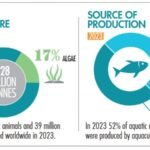Aquaculture and environmental consultants Jonah van Beijnen and Gregg Yan outline some of the key developments they expect to take place in the Asian aquaculture sector in the year ahead.
Every year, aquaculture increases its contribution to global seafood production. The sector generated 110.2 million tonnes in 2016, valued at US $243.5 billion and constituting 53 per cent of world seafood supply. According to FAO data, 90 per cent of production volume was produced in Asia. To maximise investment growth while minimising ecological impacts, it pays to identify and analyse upcoming opportunities.
China is looking to develop its offshore aquaculture production, aided by the development of new net pen farming systems.
Western approaches
The growing middle-class in China, India and other developing nations is boosting demand for higher-value western seafood such as Atlantic salmon – traditionally farmed or caught wild in colder regions. China, in particular, is becoming a major salmon importer, with 70,000 tonnes of salmonids consumed yearly, mostly imported from Chile, Denmark and Norway. To reduce import dependence and prices, Chinese farmers are attempting to raise salmon and other temperate fish like trout.
Among the most ambitious salmonid projects is a US $143.9 million farm currently operating in the Yellow Sea using a 30-metre high and 180-metre wide cage. This is the world’s largest submersible cage and can change depth from four to 50 metres for optimal temperature. Operator Wanzefeng Fishery aims to produce 1,600 tonnes of salmon by 2020, with plans to eventually upscale production to 20,000 tonnes yearly. Another government-backed farm aims to annually produce 20,000 tonnes in an inland recirculating aquaculture system (RAS) facility in Ningbo, eastern China.
More information at: https://www.roboticagriculture.com/asian-aquaculture-trends-for-2019/
Stay Always Informed
Join our communities to instantly receive the most important news, reports, and analysis from the aquaculture industry.
Editor at the digital magazine AquaHoy. He holds a degree in Aquaculture Biology from the National University of Santa (UNS) and a Master’s degree in Science and Innovation Management from the Polytechnic University of Valencia, with postgraduate diplomas in Business Innovation and Innovation Management. He possesses extensive experience in the aquaculture and fisheries sector, having led the Fisheries Innovation Unit of the National Program for Innovation in Fisheries and Aquaculture (PNIPA). He has served as a senior consultant in technology watch, an innovation project formulator and advisor, and a lecturer at UNS. He is a member of the Peruvian College of Biologists and was recognized by the World Aquaculture Society (WAS) in 2016 for his contribution to aquaculture.


